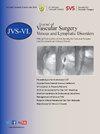腹内静脉直接通路的可行性、安全性及临床应用。
IF 2.8
2区 医学
Q2 PERIPHERAL VASCULAR DISEASE
Journal of vascular surgery. Venous and lymphatic disorders
Pub Date : 2025-09-01
DOI:10.1016/j.jvsv.2025.102309
引用次数: 0
摘要
目的:探讨超声引导下经皮腹扩张静脉栓塞治疗血管畸形的可行性、安全性及临床应用价值。方法:回顾性分析超声引导下经皮腹腔静脉栓塞治疗血管畸形患者的病历、影像学检查和手术细节,包括盆腔静脉、腹膜后静脉和肠系膜静脉。结果:9例患者(年龄范围:3-58岁)共进行了25次手术,共38次直接经皮静脉通路。进入部位包括腹膜后静脉(n=12)、扩张和弯曲的髂内静脉分支(n=8)、肠系膜上静脉(n=8)、肠系膜下静脉(n=1)、回结肠静脉(n=8)和右结肠静脉(n=1)。导管尺寸从3到5法国不等。所有手术在技术上都是成功的。发生7例轻微的通路相关并发症,均采用保守治疗。结论:超声引导下经皮腹腔静脉扩张术是可行的,且发病率低。它为需要进入深腹静脉的复杂血管畸形患者提供了一个有价值的选择。本文章由计算机程序翻译,如有差异,请以英文原文为准。
Direct Percutaneous Abdominal Venous Access for Endovascular Therapy
Objective
To evaluate the feasibility, safety, and clinical applications of ultrasound-guided direct percutaneous access to ectatic abdominal veins for the embolization of vascular malformations.
Methods
Medical records, imaging studies, and procedural details were retrospectively reviewed for patients who underwent embolization procedures for vascular malformations with ultrasound-guided percutaneous access to intra-abdominal veins, including the pelvic, retroperitoneal, and portomesenteric veins.
Results
A total of 38 direct percutaneous vein accesses were performed across 25 procedures in 9 patients (age range, 3-58 years). Access sites included retroperitoneal veins (n = 12), dilated and tortuous internal iliac vein branches (n = 8), the superior mesenteric vein (n = 8), the inferior mesenteric vein (n = 1), ileocolic vein (n = 8), and right colic vein (n = 1). Catheter sizes ranged from 3F to 5F. All procedures were technically successful. Seven minor access-related complications occurred; all were managed conservatively.
Conclusions
Ultrasound-guided percutaneous access to dilated intra-abdominal veins is feasible and associated with minimal morbidity. It offers a valuable alternative for patients with complex vascular malformations requiring access to deep abdominal veins.
求助全文
通过发布文献求助,成功后即可免费获取论文全文。
去求助
来源期刊

Journal of vascular surgery. Venous and lymphatic disorders
SURGERYPERIPHERAL VASCULAR DISEASE&n-PERIPHERAL VASCULAR DISEASE
CiteScore
6.30
自引率
18.80%
发文量
328
审稿时长
71 days
期刊介绍:
Journal of Vascular Surgery: Venous and Lymphatic Disorders is one of a series of specialist journals launched by the Journal of Vascular Surgery. It aims to be the premier international Journal of medical, endovascular and surgical management of venous and lymphatic disorders. It publishes high quality clinical, research, case reports, techniques, and practice manuscripts related to all aspects of venous and lymphatic disorders, including malformations and wound care, with an emphasis on the practicing clinician. The journal seeks to provide novel and timely information to vascular surgeons, interventionalists, phlebologists, wound care specialists, and allied health professionals who treat patients presenting with vascular and lymphatic disorders. As the official publication of The Society for Vascular Surgery and the American Venous Forum, the Journal will publish, after peer review, selected papers presented at the annual meeting of these organizations and affiliated vascular societies, as well as original articles from members and non-members.
 求助内容:
求助内容: 应助结果提醒方式:
应助结果提醒方式:


